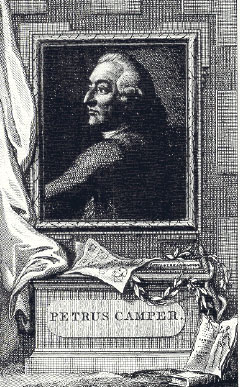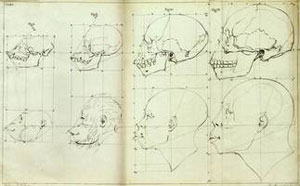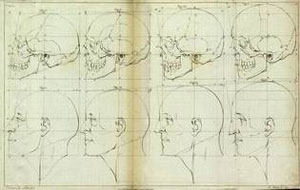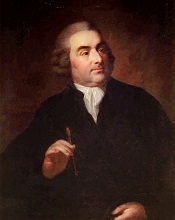|
|

Petrus Camper (1722-1789)
In the eighteenth-century Dutch Republic, Petrus Camper was second only to Hermann Boerhaave (1668-1738) in international renown. But he would have been astonished by his posthumous reputation that he initiated racist craniology. The anthropological positions that his name came to represent by the nineteenth century were diametrically opposed to his actual beliefs, which were monogenist, environmentalist, and relativist in aesthetics.
Camper’s racist reputation originated from his illustrations of animal and human profiles, taken out of its original context. The acute jaw angle became synonymous with “primitivism,” “savagery,” or “mental deficiency.” While the graphical stereotype can be traced to the Ancients, who assigned “barbarians” or “monsters” to regions remote in place or time, the new factor in early modern science was the primitive’s simian nature. The receding forehead and protruding jaw of the ape were attributed to “lower races” and the association was blamed on Camper because he had established the facial angle as a standard for “beauty.”
Camper’s aesthetics were more complicated. After life-long observations of mammalian and human crania arrested in various stages of life, this comparative anatomist speculated on the laws behind the existing diversity of cranial shapes. He sawed several skulls perpendicularly down the middle. While uniformity was evident in the brain cavity’s oval form, Camper concluded that the key to pluriformity rested in the variable extension of the jaw and its resulting impact on craniofacial morphology. He then extrapolated that the Ancients had used this insight for their beloved “ideal beauty;” an optical correction for vision distorted from perspective.
The series of profiled heads drawn by Camper manifested a progressive increase of the jaw’s angle in profile. The spatial arrangement of an organism’s parts being materially fixed, changes in one part of the organism entailed changes in the other parts. Facial characteristics were so interdependent that the retraction or protrusion of the jaw determined whether the nose was flat or long and the lips broad or thin. Variation of any one racial feature immediately modified the mutually-related parts, resulting in the characteristic physiognomies of species, human ages and nations.
Camper wanted to disprove the still current belief that unfamiliar racial traits were derived from postnatal intervention. Gifted as both a comparative anatomist and draftsman, he was more astute about the nature of aesthetic prejudice than the layman. The old belief that thick lips, flat noses, or stretched eyes had been manipulated by midwives or mothers immediately after birth implied that foreign physiognomy was too “ugly” to be “natural.” In Christianity, moreover, body tampering had sinful connotations and suggested moral debasement.
Georges Buffon, for example, had suggested that the flattened African nose resulted from babies accidentally striking their noses against the back of their mothers, and that this acquired characteristic became an inheritable one. Camper, in contrast, argued that the decreased facial angle in Africans materially forced the nose to flatten anatomically. The upper lips of Africans had to stretch farther to compensate for the acute angle. Likewise European long noses resulted from their obtuse angle and never from artificial nose-stretching. Camper’s drawings were meant to demonstrate the actual mechanism of the physiognomical variation that was observed in nature.
Camper’s method involved the transference of the cranial form onto paper (in the manner of an architect), and tracing a “facial line” from the front of the incisor teeth to the prominent part of the forehead. This linea facialis intersected a horizontal line, drawn from the nosebase to the earhole, thereby producing what his successors termed the “facial angle.” Eventually professional anthropologists coined this physical feature as “prognathism;” the term is not infrequently mentioned as a means of indentification in the forensic crime shows that are so popular on television nowadays.
The angle that Camper outlined ascended through the profile of a tailed monkey (42°), through a small orangutan, on which he had published the first monograph, (58°), the Kalmuck Asian and the Angolan African (both 70°), and the European’s near-vertical (80°) angle. This peak could be surpassed “by the rules of art alone,” as in the classical sculpture of the Apollo Belvedere which stood at the head of Camper’s sequence (100°).
|
 
|
Even though Camper’s general observation was not new — e.g. Albrecht Dürer (1471-1528) preceded him, his reduction of the craniofacial profile to a simple geometric expression that could be readily quantified was an original contribution. Its simplicity had great power: it had a profound impact on the development of morphology and physical anthropology. But it also, unfortunately, ultimately became a racist icon.
 The complete set of Camper’s engravings indicates that the facial angle was not meant to be understood solely in profile but in three dimensions, in the context of what biologists later called the “principle of the correlation of parts.” Camper’s preoccupation with determining the source of diversification, along with the common denominators of dynamic forms, is a form of study now specified as “morphology,” the study of form.
The complete set of Camper’s engravings indicates that the facial angle was not meant to be understood solely in profile but in three dimensions, in the context of what biologists later called the “principle of the correlation of parts.” Camper’s preoccupation with determining the source of diversification, along with the common denominators of dynamic forms, is a form of study now specified as “morphology,” the study of form.
“One consequence of the Darwinian revolution for craniometry was to arrange the Camperian sequence of angles in a temporal succession. Once the steps represented by God’s discrete creation of separate species had been replaced by the transformation of one species into another — or monkeys into men, as was popularly said ... Camper’s ‘negro’ could be stigmatized as evolutionarily more primitive. The nineteenth-century campaigns of craniological measurement and ethnographic photography, together with huge collections of skull types, provided great banks of data that could be exploited to detect those races that stood closest to the animal origins of man” (Martin Kemp, “Slanted Evidence,” Nature 402 (1999): 727).
The three-dimensional quality of Camper’s drawings became completely overlooked. Long forgotten is how his theory illustrated that differences between the races were natural geometrical consequences. Camper explained that what people found beautiful or ugly was a matter of habit or familiarity. Implicitly he was trying to untangle the confusion between the naturalness/unnaturalness and beauty/ugliness of non-European physiognomies.
While Camper’s objective was to prove that the denaturalization of black people, based on their looks, was empirically false, racists exploited his facial angle graphic as a supposedly “objective” scientific proof for white supremacy. “The progressive misuse of Camper's non-racist characterizations is a salutary reminder of what can happen to apparently ‘neutral’ results when a climate of belief is radically transformed” (Martin Kemp, “Slanted Evidence,” Nature 402 (1999): 727).
|
book@petruscamper.com
[ home ]
[ reviews ] [ texts ] [ projects ] [ order ] [ sitemap ]
Miriam Claude Meijer, Ph.D. © All Rights Reserved
|



